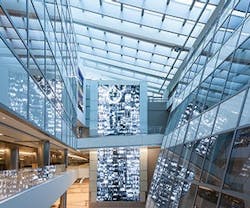Using technology is second nature to most of us in the 21st century. We spend our days sending #robots @messages that would have looked like gibberish in the last millennium. We make purchases by tapping our smartphones to credit card screens. We see frustrated babies in YouTube videos try to “swipe” the pages of magazines in vain.
Psychologist, sociologist and Massachusetts Institute of Technology professor Sherry Terkle was ahead of her time when she published a book studying technology as The Second Self in 1984. By April 2012, she was issuing a warning from the TEDTalk stage: “[When] we sacrifice conversation for mere connection, we shortchange ourselves. … We expect more from technology and less from each other.”
As the digital trappings of the Technological Age build up around us, have we begun to shut out our sense of community?
Fortunately, this is an age that changes so quickly, we may already be moving past it.
According to Ayesha Kharina, founder of the Hybrid Reality Institute, “mankind is now experiencing its fifth and most intense technological revolution, and we are transitioning into the Hybrid Age.”
The new age is marked by five distinct changes, Kharina says: technology is becoming more ubiquitous, intelligent, social, integrated and disruptive. It is also becoming an increasingly useful tool for designers to create dynamic spaces that get us to put down our screens and pick up a conversation.
“It’s another layer of architecture that is now alive,” says Marcela Sardi, owner of Sardi Design and an integral player in the creation of the new Tom Bradley International Terminal (TBIT) at Los Angeles International Airport (LAX).
TBIT is now home to the largest immersive multimedia system of any airport in the Americas. It is helping to define what the world will look like in a new, Hybrid Age.
Using the latest in high-resolution imaging, 3-D effects and technologies that react to people’s movements and real-time airport information, the multimedia environment meets the essential functionality of the airport, while turning the terminal into a spectacular place to spend time.
“It’s a really exciting time where this crossing over of public space, light, entertainment and art is creating meeting grounds for people in new ways,” says Melissa Weigel, senior multimedia director of Moment Factory, who was commissioned as executive content producer for TBIT. “Ten years ago the technology for the software, or even the hardware, wouldn’t have allowed the same level of quality of content as it may now.”
Projects in the Hybrid Age are marked by complexity. “The big issue is how do you do things that are pretty and seamless, but also simple enough to be maintained?” asks Sardi.
It took more than 300 people three and a half years to answer that question for LAX. Sardi Design and MRA International designed the media features; Fentress Architects designed the terminal and supported the media intervention; Smart Monkeys Inc. handled system design and engineering; Electrosonics integrated the whole system; and Moment Factory and Digital Kitchen produced the content.
Design teams like this know that technology and multimedia are no longer an afterthought. When you’re talking about 6,480 square feet of LED surfaces, like on TBIT’s Time Tower (now the world’s largest interactive feature), you don’t want your entire design to go blank because of an IT glitch. Nor do you want visitors to go blind from the extra glow when it’s working. TBIT was initially outfitted with HIDs, which had to be retrofitted and replaced with LEDs that were more responsive to changing screen images.
Even when collaborative teams integrate early, arguments are to be expected. According to Sardi, compromise is critical to success, and made easier by defining a clear vision that everyone can understand.
“Most of the time you see media being introduced without anyone knowing what is going to be playing,” she says. “There are a lot of different pieces of technology out there, and you need to know what you want the content to do in order to specify the right thing and actually integrate it. Otherwise, it could go very wrong.”
When done correctly, technology-driven design can create an immersive, participatory environment that puts users at the helm of their own experience. Information-rich content that blurs the line between art and utility can create inspiring interactions out of everyday tasks. Responsive displays allow viewers to shape the environment around them and engage with their peers—not from screen to screen, but from person to person on one shared system.
“How do you get people to talk to each other? That’s why parks and public spaces were developed: for people to go and form a community,” Sardi says. “If you create an experience that people can actually talk about, they take their eyes off their phones, they look at the space and they understand where they are.”
To watch Sherry Turkle’s full TED talk: http://bit.ly/12iOAJJ
To see a video about the LAX project: http://bit.ly/1eXemFY
